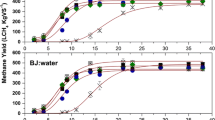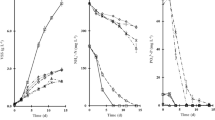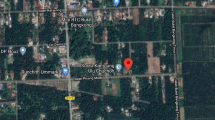Abstract
In many countries, the algae of “green tides” are harvested in the fight against pollution. Ulva often represents the main component of the tide, and intensive research has been conducted on the possibility to use the algae as a methanisation substrate. However, methanisation is hampered by various practical obstacles, which requires a compromise between productivity and biological yield.
The process described here calls upon a pre-digestion phase of Ulva which, besides the economy of time and volume of the digestion, makes it possible to obtain a biogas of good quality. The methanisation substrate is the hydrolysis juice collected by draining, followed by pressing. The cake resulting from the pressing process can be used as organic enriching or fertilizing agent in agriculture. Various presses were tested. The screw press was found the most suitable to recover a great quantity of sufficiently loaded pressing juice after only a short hydrolysis time. For a 3 month hydrolysis period, the different fractions amounted to 158 L of hydrolysis juice, 192 L of pressing juice, and 0.075 m3 of cake per m3 of initial algae.
The bi-phasic anaerobic digestion with forced recuperation of juices offers interesting pollution abatement perspectives, with total and soluble chemical oxygen demand cleaning rates of respectively 79 and 95% during the methanogenic phase, for a volume productivity of 1.5 m3 CH4 m−3digester day−1. The quality of the Ulva juice also makes it suitable for use as substrate for industrial processes or co-substrate of methanisation in pre-existing reactors, so that subsequent investment could be avoided.
Similar content being viewed by others
References
Baskerville RC, Komorek JA, Gale RS (1971) Effet of operating variables on filter press performance. Wat. Pollut. Control 1971: 400–418.
Briand X, Morand P (1997) Anaerobic digestion of Ulva sp. 1. Relationship between Ulva composition and methanisation. J. Appl. Phycol. 9: 511–524.
Charlier RH, Morand P (2005) Use, role and nuisance aspects of algae in coastal and related ecosystems: the importance of controlling eutrophication. In: Chircop A, McConnell M (eds) Ocean Yearbook 19. The University of Chicago Press, Chicago, pp. 127–137.
de Jonge VN, Elliott M, Orive E (2002) Causes, historical development, effects and future challenges of a common environmental problem: eutrophication. Hydrobiologia 475/476: 1–19.
Elefsiniotis P, Wareham DG, Smith MO (2004) Use of volatile acids from an acid-phase digester for denitrification. J. Biotechnol. 114: 289–297.
Fletcher RL (1996) The occurrence of “green tides” – a review. In: Schramm W and Nienhuis PH (eds) Marine benthic vegetation. Recent changes and the effects of eutrophication. Springer-Verlag, Berlin, pp. 7–43.
Lahaye M (1998) NMR spectroscopic characterisation of oligosaccharides from two Ulva rigida ulvan samples (Ulvales, Chlorophyta) degraded by a lyase. Carbohydr. Res. 314: 1–12.
Lim SJ, Choi DW, Lee WG, Kwon S, Chang HN (2000) Volatile fatty acids production from wastes and its application to biological nutrient removal. Bioproc. Eng. 22: 543–545.
Manclère P (1985) Méthanisation des algues: de l'énergie à revendre? Équinoxe 3: 7–12.
Merceron M (1999) Inventaire des ulves en Bretagne–Année 1998. Rapport de synthèse (Study of Ulva proliferations in Brittany–Year 1998. Synthetic report). R. Int. DEL/99.15/Brest. Agence de lapos;au Loire-Bretagne, Orléans, France – IFREMER, Plouzané, France. 26 + II pp.
Missoni G, Mazzagardi M (1985) Production of algal biomass in Venice Lagoon, environmental and energetic aspects. In: Palz W, Coombs J, Hall DO (eds) Energy from Biomass. Elsevier Applied Science, London, pp. 384–386.
Morand P, Briand X (1996) Excessive growth of macroalgae: a symptom of environmental disturbance. Bot. Mar. 39: 491–516.
Morand P, Briand X (1999) Anaerobic digestion of Ulva sp. 2. Study of Ulva degradation and methanisation of liquefaction juices. J. Appl. Phycol. 11: 165–177.
Morand P, Merceron M (2004) Coastal eutrophication and excessive growth of macroalgae. In: Pandalai SG (ed.) Recent Ressearch Developments in Environmental Biology 1. Research Signpost, Trivandrum, India, pp. 395–449.
Nedergaard RI, Risgaard-Petersen N, Finster K (2002) The importance of sulfate reduction associated with Ulva lactuca thalli during decomposition: a mesocosm experiments. J. Exp. Mar. Biol. Ecol. 275: 15–29.
Orlandini M, Favretto L (1988) Utilization of macroalgae in Italy for pollution abatment and as source of energy and chemicals. In Morand P, Schulte EH (eds) Aquatic Primary Biomass (Marine Macroalgae): Biomass Conversion, Removal and Use of Nutrients. I. Commission of the European Communities, DG XII/F Biotechnology, Brussels, pp. 25–28.
Pelayo Ortiz C, Steyer J-P, Bories A (1997) Carbon and nitrogen removal from wastewater by Candida utilis: kinetics aspects and mathematical modelling. Process Biochem. 32: 179–189.
Pelé E (1982) Inventaire des déchets valorisables en agriculture dans le département des Côtes-du-Nord. Chambre dapos;griculture, Saint-Brieuc, France, pp. 110.
Reid KC, Jackson P (1956) Non thermal drying of brown marine algae. J. Sci. Food Agric. 7: 291–300.
Schoutteten F (2004) Valorisation non alimentaire des agro-ressources. Fiche technique agro-industrie. CRCI/ARIST Champagne-Ardenne, Châlons-en-Champagne, France, 6 pp.
Uchida M, Murata M (2004) Isolation of a lactic acid bacterium and yeast consortium from a fermented material of Ulva spp. (Chlorophyta). J. Appl. Microbiol. 97: 1297–1310.
Wilkinson L (1963) Nitrogen transformations in a polluted estuary. Int. J. Air Water Poll. 7: 737–752.
Xu Y (1996) Volatile fatty acids carbon source for biological denitrification. J. Environ. Sci. 8: 257–268.
Author information
Authors and Affiliations
Corresponding author
Rights and permissions
About this article
Cite this article
Morand, P., Briand, X. & Charlier, R.H. Anaerobic Digestion of Ulva sp. 3. Liquefaction Juices Extraction by Pressing and a Technico-Economic Budget. J Appl Phycol 18, 741–755 (2006). https://doi.org/10.1007/s10811-006-9083-1
Received:
Revised:
Accepted:
Published:
Issue Date:
DOI: https://doi.org/10.1007/s10811-006-9083-1




